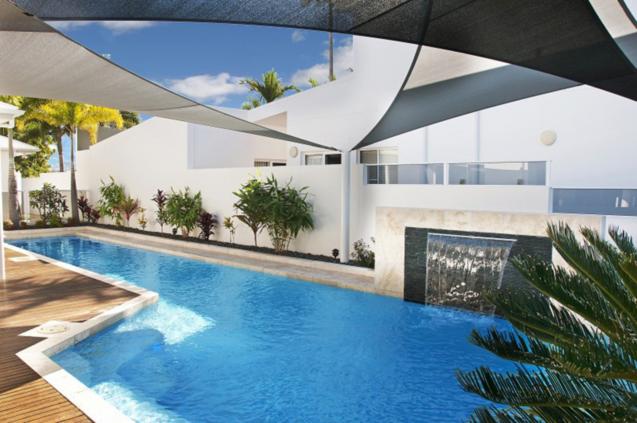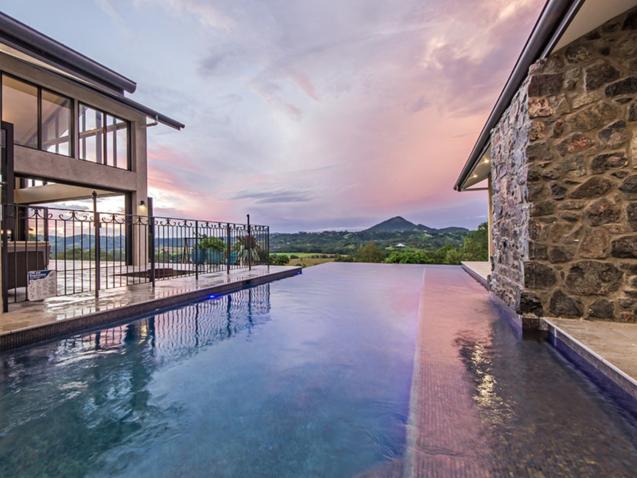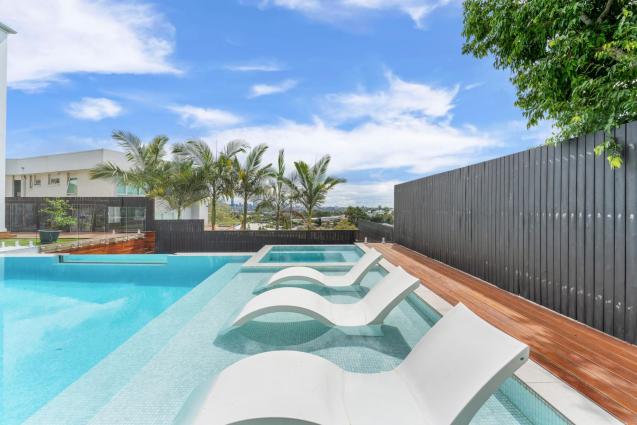
Plunge Pools: Uses, Benefits & Factors to Consider When Building One
By Ecozen Pools + Landscapes|June 09, 2023
When it comes to contemporary architecture, swimming pools have become an indispensable addition to residences. While new designs and features are always evolving and being integrated into modern homes, few are as functional or as beneficial as a swimming pool. It comes as no surprise then, that pools can be found in almost every home these days, particularly ones that are situated in warmer climates.
When discussing practicality and benefits related to pools, you can’t overlook the plunge pool. Despite its name indicating that it’s somehow different from a standard swimming pool, it is fast becoming a popular choice for both homes and luxury villas alike.
If you haven't yet come across a plunge pool before, or don't fully understand what the appeal is, this article will outline everything you need to know about them.
What is a plunge pool?
A plunge pool is a compact pool designed specifically for relaxing and bathing. Plunge pools are essentially the same as ordinary backyard swimming pools, but they occupy a significantly smaller area and generally aren’t suitable for swimming laps. The dimensions of a plunge pool are approximately one-third of the average swimming pool size, while maintaining a similar depth. Plunge pools have lengths ranging from 2 to 6 metres and widths of 2 to 3.5 metres. The average depth of a plunge pool is around 1.2 metres, although it can occasionally be deeper to offer greater versatility.
The concept of the plunge pool was originally inspired by the natural basins found at the base of waterfalls. However, it has evolved into a highly popular pool option and is gradually becoming a prevailing trend today, owing to its numerous advantages. The compact size makes it a perfect fit for both small and larger sized houses, allowing homeowners to install it in their backyard without occupying an excessive amount of real estate.
Uses of plunge pools
Plunge pools are similar to regular pools, with the main distinction being their smaller dimensions. Their uses are largely similar, but their smaller size makes them less suitable for families, or young children wanting to splash about in a wider space.
Despite their compact size, these pools are ideal for relaxing, giving them unique therapeutic qualities. The plunge pool represents an ideal area to cool off or unwind on a leisurely afternoon.
Plunge pools can be excellent for hydrotherapy, offering a beneficial experience that can help soothe the mind. Additionally, these pools are recommended for low-impact exercises, which involve less strenuous physical exertion.
Benefits of a plunge pools
There are numerous benefits to owning a plunge pool, but the following are the most notable advantages you can enjoy:
How are Plunge Pools Built?
Constructing a plunge pool follows a similar process to that of a standard-sized swimming pool, with the primary distinction lying in the dimensions. However, when it comes to plunge pools, you have the flexibility to choose between an in-ground or above-ground pool design. In-ground pools are commonly preferred, as they offer a more natural and visually appealing aesthetic. Nevertheless, above-ground plunge pools are easier to construct since minimal installation is required.
The majority of homeowners who decide to have a plunge pool installed, choose to go with an in-ground pool design. Another important decision to make is the material from which your pool will be constructed. Concrete pools are more popular due to their luxurious aesthetic. On the other hand, fibreglass pools are also popular, due to their less time-consuming installation process. DIY pools are also an option, but it is important to note that such pools are typically temporary in nature.
Factors to consider when building a plunge pool
Owning a plunge pool can be an enjoyable experience, but the process of building one can still carry its own set of challenges. While construction work is entrusted with professional pool builders, you still need to make important decisions to help ensure that end the end result is one to your liking.
The following is a list of factors to consider that can simplify the decision-making process:
Plunge pools have grown in popularity among homeowners in recent times, due to their smaller footprint and significant benefits. This article has outlined everything you need to know about plunge pools.
When discussing practicality and benefits related to pools, you can’t overlook the plunge pool. Despite its name indicating that it’s somehow different from a standard swimming pool, it is fast becoming a popular choice for both homes and luxury villas alike.
If you haven't yet come across a plunge pool before, or don't fully understand what the appeal is, this article will outline everything you need to know about them.
What is a plunge pool?
A plunge pool is a compact pool designed specifically for relaxing and bathing. Plunge pools are essentially the same as ordinary backyard swimming pools, but they occupy a significantly smaller area and generally aren’t suitable for swimming laps. The dimensions of a plunge pool are approximately one-third of the average swimming pool size, while maintaining a similar depth. Plunge pools have lengths ranging from 2 to 6 metres and widths of 2 to 3.5 metres. The average depth of a plunge pool is around 1.2 metres, although it can occasionally be deeper to offer greater versatility.
The concept of the plunge pool was originally inspired by the natural basins found at the base of waterfalls. However, it has evolved into a highly popular pool option and is gradually becoming a prevailing trend today, owing to its numerous advantages. The compact size makes it a perfect fit for both small and larger sized houses, allowing homeowners to install it in their backyard without occupying an excessive amount of real estate.
Uses of plunge pools
Plunge pools are similar to regular pools, with the main distinction being their smaller dimensions. Their uses are largely similar, but their smaller size makes them less suitable for families, or young children wanting to splash about in a wider space.
Despite their compact size, these pools are ideal for relaxing, giving them unique therapeutic qualities. The plunge pool represents an ideal area to cool off or unwind on a leisurely afternoon.
Plunge pools can be excellent for hydrotherapy, offering a beneficial experience that can help soothe the mind. Additionally, these pools are recommended for low-impact exercises, which involve less strenuous physical exertion.
Benefits of a plunge pools
There are numerous benefits to owning a plunge pool, but the following are the most notable advantages you can enjoy:
- Space saving: Swimming pools have become a popular addition to homes, particularly during the summer when you seek respite from the heat. However, if you reside in an apartment or live in an area where space is a premium, accommodating a full-sized pool may not be feasible. Fortunately, plunge pools have minimal space requirements, allowing you to install this luxurious amenity in a modest sized backyard.
- Easier Maintenance: Another significant benefit of owning a plunge pool is the ease of maintenance. It's quite straightforward; the smaller size of plunge pools translates to less time and effort required for cleaning and upkeep.
- Cost-effective: There are two ways that plunge pools save you money. Firstly, installing a plunge pool in your home costs less compared to a full-sized pool. Secondly, the ongoing expenses associated with maintaining the pool, such as water and chemical treatments, are significantly reduced since you require less of these resources for refilling and treatment.
- Enhances Home Design: Even the smallest of pools can greatly enhance the aesthetics of your yard. The visually appealing feature can also add value to your home and make it more appealing to potential buyers.
How are Plunge Pools Built?
Constructing a plunge pool follows a similar process to that of a standard-sized swimming pool, with the primary distinction lying in the dimensions. However, when it comes to plunge pools, you have the flexibility to choose between an in-ground or above-ground pool design. In-ground pools are commonly preferred, as they offer a more natural and visually appealing aesthetic. Nevertheless, above-ground plunge pools are easier to construct since minimal installation is required.
The majority of homeowners who decide to have a plunge pool installed, choose to go with an in-ground pool design. Another important decision to make is the material from which your pool will be constructed. Concrete pools are more popular due to their luxurious aesthetic. On the other hand, fibreglass pools are also popular, due to their less time-consuming installation process. DIY pools are also an option, but it is important to note that such pools are typically temporary in nature.
Factors to consider when building a plunge pool
Owning a plunge pool can be an enjoyable experience, but the process of building one can still carry its own set of challenges. While construction work is entrusted with professional pool builders, you still need to make important decisions to help ensure that end the end result is one to your liking.
The following is a list of factors to consider that can simplify the decision-making process:
- Cost: Before making the decision to build a plunge pool, it’s important to consider the cost of your preferred pool design and ensure that it fits within your budget. This step helps prevent financial strain or unnecessary extravagance.
- Space: Plunge pools do not have a fixed size, allowing you to customise your pool design to be larger or smaller than the average plunge pool. However, it’s a good idea to consider the available space to avoid any regrets regarding the size of the pool. Your pool builder will work with you to ensure that your backyard space can accommodate the size of pool that you desire.
- Contractor: While it may be tempting to cut costs when undertaking pool build, opting to hire a less reputable swimming pool contractor in the hopes of securing a ‘bargain’, could have disastrous consequences. It is crucial to select an experienced pool builder who can handle the project with expertise. Properly built plunge pools that utilise quality materials can last for many decades.
Plunge pools have grown in popularity among homeowners in recent times, due to their smaller footprint and significant benefits. This article has outlined everything you need to know about plunge pools.



